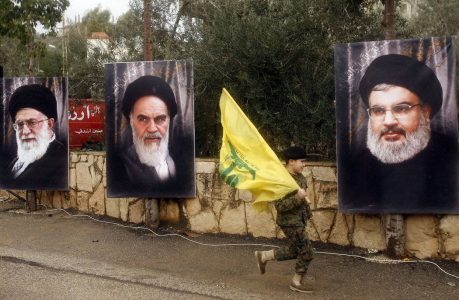
Iran turns to ally Hezbollah after Soleimani’s assassination
On January 3, America assassinated Iran’s top General Qassem Soleimani in a drone strike and said he presented an imminent threat to America’s security. It has been more than two months to the killing but Donald Trump’s government has failed to reveal any convincing evidence to back that claim. Instead, Soleimani’s killing has been seen as a part of America’s ‘maximum pressure’ campaign against Iran to curb its influence in the region neighboring Israel.
Soleimani was the most important military figure in the Islamic republic tasked with creating a region of influence for Iran- from Tehran, through Iraq and Syria all the way to the Mediterranean. He had nurtured and sustained Shia militias in Iraq, Syria, Yemen, and Lebanon to do Tehran’s bidding and often mediated among the quarreling factions. Soleimani was the leader of the elite Islamic Revolutionary Guard Corps [IRGC] and the commander of the Quds force – a specialized unit of unconventional warfare and military intelligence operations in the country.
The assassination of the spy who weaved a net of Shia paramilitary groups flew frequently without being noticed and scored major victories against ISIS, sent a clear message to the entire conglomerate of the IRGC and its allies- anyone could be next. The boom of the explosion at Baghdad airport at about 1 am on a Thursday night, which killed Soleimani, had wide-ranging ramifications for Iran and its friends and it resonated across the Middle East.
It brought Shia majority Iraq – home to some of the strongest Iran-funded militias to the brink of war with America. Iran benefitted out of the US’s toppling of Saddam Hussein in 2003 as the subsequent governments were all Shia led by men Iran had cultivated. But over time, Iran’s expansion in the region had also begun to irk the hardliners in Washington who advocated reining Tehran in. The majority of Iraqis, however, wanted nothing to do with either the US or Iran. In fact, quelling outside interference was a major demand during the recent uprising in the oil-rich but conflict-ridden country.
Iran’s militias, however, are the most powerful, armed entities in Iraq that merged into Iraq’s Army in 2016. And while they put up a united front in the fight against ISIS, since its territorial defeat they have been caught up in internal battles over lucrative government positions that allow more rent seeking.
Soleimani used to resolve their differences and work out solutions to please individual egos as long as Iran’s interests were served. But his death- along with Abu al-Muhandis, the Iraqi militia leader who died in the same strike as Soliemani, has deepened the divide. Tehran is concerned that sans Soleimani’s leadership the militias may end up disintegrating and it may lose all its victories in Iraq to other actors.
In Syria, Iranian proxy Hezbollah took the lead and played the role of Bashar al-Assad’s infantry as Russia took the skies. Soleimani coordinated the war on the ground. Here, Iran is worried about losing space to Russia, an ally of an ally but with a completely different end game in mind. Russia has had a working relationship with Israel and has let it bomb Iranian assets in Syria. Iran sees Israel as its mortal enemy.
Tehran was already reeling under debilitating sanctions imposed by the US in 2018 after American President Donald Trump walked out of the Joint Comprehensive Plan of Action [JCPOA] or Obama era’s Iran-US nuclear deal. In his attempt to leave Iran no choice but to accede to America’s demands – mainly to get out of the region of influence Iran was building in Israel’s vicinity – Trump even waived the exemption to eight countries that had continued to buy Iran’s oil and ensured its survival.
Yet, despite all sorts of pressure, Iran has stood steadfast in its pursuit and refused to give in. The day after Soleimani’s killing, Iran nominated his deputy – General Ismail Ghaani, as his replacement.
An equal in military and counterintelligence experience, Ghaani is far less charismatic- an essential quality to navigate through the massive Iranian operation in the region and get its myriad militias to fall in line. Moreover, he is known as an Afghanistan hand and does not even speak Arabic.
Iran, it seems, has handed over the larger chunk of Soleimani’s responsibilities to Hassan Nasrallah- Secretary-General of the Lebanese political and paramilitary party Hezbollah and the only other leader who equaled Soelimani’s appeal among its militias.
Under his leadership, Hezbollah not only pushed back the Israeli army in 2006 but also took over Lebanon- first the streets by decisively defeating the government forces in clashes in 2008 and subsequently the parliament. The last government in the country comprised of an alliance dominated by Hezbollah and the current one- installed after the October uprising, has its blessings.
Hezbollah, for some time now, has been training the foot soldiers of Iran’s militias in Iraq, assisting in the recruitment of disaffected Shias from Afghanistan and Pakistan and co-strategizing the policy with Iran on how to respond to America.
The group is seen more as an ally by Iran’s clerical regime and no longer just a proxy. Moreover, no one other than Nasrallah could match Soleimani’s popularity in Iran’s regional army. The IRGC and Hezbollah are now slowly but steadily working on unifying their many branches to eventually oust the Americans from Iraq. That may not work but it will boost up the morale of the fighters after the tallest among them was assassinated.
Source: Eurasia View





